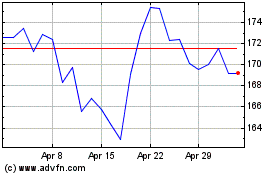Irene Lands Punch On N Carolina, But Is No Floyd -Disaster Modelers
August 27 2011 - 3:38PM
Dow Jones News
Hurricane Irene has landed a solid punch on North Carolina, but
it isn't causing the widespread catastrophic damage that had been
feared just two days ago, according to disaster experts.
But that doesn't mean the Northeast will be similarly spared.
North Carolinians are practiced at weathering hurricanes and
fighting off floodwaters. Further north, fewer homes have been
tested by sustained hurricane-force winds and the ground is already
saturated by days of heavy rain.
"The Northeast can't rest easy," said Jose Miranda of
disaster-modeling company Eqecat Inc. "When all is said and done, I
think this will be remembered more as a Northeast storm than a
North Carolina storm."
Currently, North Carolinians are enduring sustained 85
mile-an-hour winds near the hurricane's center. The wind is causing
roof tiles to fly loose and siding to peel away, and the heavy
rains are making it easier for gusts to pull down trees.
Such damage will prove costly to repair. But it isn't as
expensive as replacing an entire home, and so far there have been
no widespread reports of houses being entirely obliterated by the
wind or water, Miranda said.
"So far damage is lighter than expected--a lot of power outages
and some flooding," said E. Stuart Powell Jr., a vice president at
Independent Insurance Agents of North Carolina, early Saturday
afternoon.
If such early reports hold true, the impact to the insurance
industry in North Carolina will be less than initially feared.
Insurers have sometimes lost $10 billion or more on a single
hurricane; the record remains 2005's Hurricane Katrina, which cost
private insurers more than $40 billion.
For North Carolina, "there will be significant damages, but
certainly not of the magnitude we saw from Floyd," Miranda
said.
Floyd caused insured losses of $1.4 billion in North Carolina
when it struck the state in 1999, according to the Insurance
Information Institute. The figure excludes the $463 million paid by
the federal government's National Flood Insurance Program.
Storm surge, the term for the ocean water pushed inland by a
hurricane, was mitigated somewhat by low tides in North Carolina,
said Matthew Nielsen, of disaster-modeling company Risk Management
Solutions Inc.
"The worst of the storm surge appears to be over," he said.
Flooding in North Carolina will be caused more by water flowing
out to the sea than the other way around, Nielsen said. His firm
was monitoring flood conditions on the Pamlico, Neuse and Roanoke
rivers.
Insurers like Allstate Corp. (ALL), Travelers Cos. (TRV) and
State Farm Mutual Automobile Insurance Co. have positioned
disaster-response teams along the east coast so they can begin
sending adjusters to the site of damaged homes as soon as Irene
passes by.
State Farm is the largest home insurer in the states in Irene's
path by premium revenue. Allstate ranks second and Liberty Mutual
Group is third, according to data collected by SNL Financial.
-By Erik Holm and Leslie Scism, Dow Jones Newswires;
212-416-2891; erik.holm@dowjones.com
Allstate (NYSE:ALL)
Historical Stock Chart
From May 2024 to Jun 2024

Allstate (NYSE:ALL)
Historical Stock Chart
From Jun 2023 to Jun 2024
